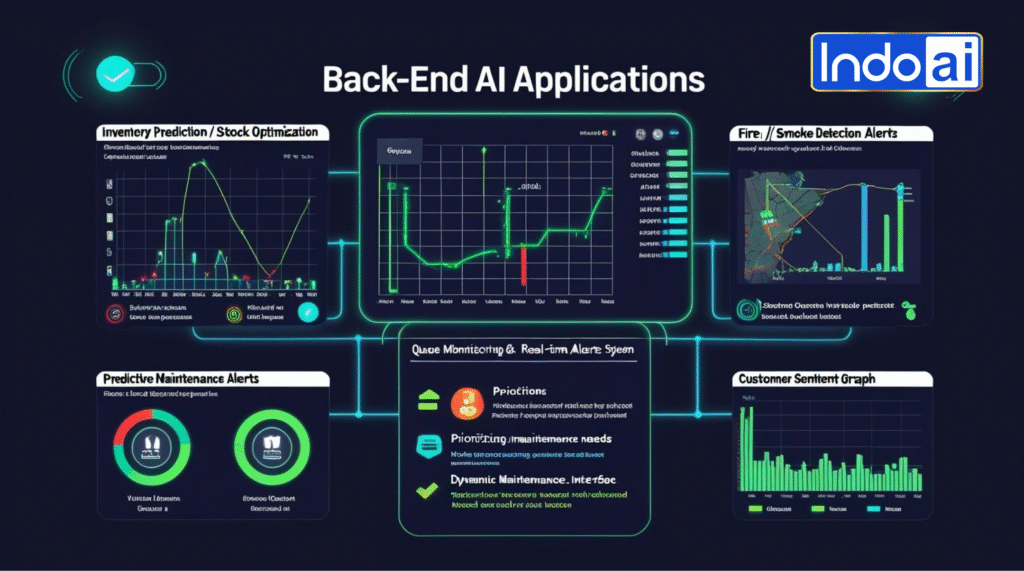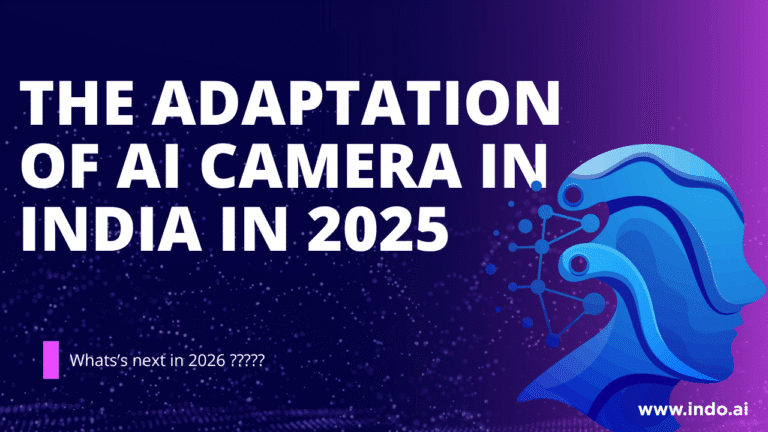Artificial Intelligence (AI) is revolutionizing industries worldwide, and the retail sector is no exception. Retail chains, in particular, are leveraging AI to optimize operations, enhance customer experiences, and improve decision-making. From personalized marketing to inventory management, AI technologies are reshaping the way retail businesses operate. Let’s dive into the detailed applications of AI in retail chains, supported by real-world examples and an introduction to how smart cameras, like the IndoAI Edge AI Camera, can bring transformative changes to retail environments.

1. Personalized Customer Experiences
AI enables retail chains to understand their customers better and provide personalized shopping experiences. By analyzing customer data such as purchase history, browsing behavior, and preferences, AI algorithms can recommend products tailored to individual needs.
Example:
Amazon uses AI-driven recommendation systems to suggest products based on a user’s browsing and purchase history. These recommendations significantly boost sales and improve customer satisfaction.
Smart Camera Integration:
Smart cameras like the IndoAI Edge AI Camera, with its face recognition capabilities, can identify returning customers (with consent) and provide personalized greetings or direct them to relevant product sections, enhancing their in-store experience.
2. Efficient Inventory Management
Managing inventory efficiently is a major challenge for retail chains. AI solutions help predict demand, optimize stock levels, and prevent overstocking or understocking by analyzing historical sales data, market trends, and seasonal patterns.
Example:
Walmart uses AI to monitor inventory levels in real-time, ensuring shelves are stocked appropriately and customers find what they need without delays.
Smart Camera Integration:
AI-powered cameras can monitor shelf space in real-time, alerting staff about low-stock or misplaced items. IndoAI’s cameras can integrate with inventory systems to automate this process, saving time and reducing human error.
3. Shoplifting Prevention and Loss Reduction
Retail chains face significant losses due to theft. AI-powered solutions, including gesture recognition models in smart cameras, can detect suspicious behaviors and alert security staff in real time.
Example:
Kroger implemented AI systems to monitor checkout areas for potential theft, significantly reducing shrinkage.
Smart Camera Integration:
The IndoAI Edge AI Camera’s gesture recognition model is designed to detect shoplifting attempts, providing instant alerts to store managers. This proactive approach helps prevent losses and ensures a safer shopping environment.
4. Dynamic Pricing Strategies
AI allows retail chains to implement dynamic pricing strategies by analyzing competitors’ pricing, customer demand, and market conditions in real-time. This ensures optimal pricing for maximum profitability.
Example:
Zara uses AI to adjust pricing based on inventory levels and market demand, ensuring timely clearance of stock while maximizing revenue.
5. Enhanced Customer Service
AI-powered chatbots and virtual assistants improve customer service by handling queries, providing product information, and assisting in returns or exchanges. These solutions are available 24/7, ensuring customer satisfaction.
Example:
H&M uses an AI chatbot to assist customers with outfit recommendations and store navigation.
6. Optimized Store Layout and Traffic Management
AI helps retailers design efficient store layouts by analyzing customer movement patterns and optimizing product placements to increase sales and reduce congestion.
Example:
IKEA uses AI to analyze in-store traffic and adjust product placements for maximum visibility and customer convenience.
Smart Camera Integration:
IndoAI Edge AI Cameras can track customer movement and provide heatmaps of high-traffic areas, helping retailers optimize store layouts and product displays.
7. Predictive Maintenance
AI-powered predictive maintenance ensures retail equipment such as refrigerators, POS systems, and lighting remain operational, preventing downtime and reducing maintenance costs.
Example:
Carrefour uses AI to predict equipment failures and schedule timely maintenance, avoiding disruptions in daily operations.
8. Fire and Safety Compliance
AI solutions ensure compliance with safety regulations by monitoring fire hazards and identifying risks in real-time.
Example:
AI-powered cameras in warehouses detect overheating or smoke, preventing major disasters.
Smart Camera Integration:
The IndoAI Edge AI Camera comes with fire and smoke detection capabilities, making it an essential tool for retail chains to ensure safety compliance and protect assets.
9. Queue Management
Long queues can frustrate customers and lead to lost sales. AI solutions monitor queue lengths and notify staff to open additional counters when needed.
Example:
Tesco uses AI to analyze queue data and optimize checkout operations.
10. Marketing and Advertising Optimization
AI helps retail chains create targeted marketing campaigns by analyzing customer demographics, purchase behavior, and preferences.
Example:
Sephora uses AI to recommend products based on customer profiles and past purchases, leading to increased engagement and sales.
11. Customer Sentiment Analysis
AI can analyze customer feedback and reviews to gauge sentiment and identify areas for improvement. This helps retail chains adapt their offerings to better meet customer expectations.
Example:
Nike uses AI to analyze social media and review data, gaining insights into how customers perceive their products and campaigns.
12. Supply Chain Optimization
AI improves supply chain management by forecasting demand, optimizing logistics, and ensuring timely delivery of products.
Example:
Unilever employs AI to optimize its supply chain, reducing costs and improving delivery timelines.
Additional AI Applications in Retail
Demand Forecasting and Supply Chain Optimization:
- Real-time Demand Prediction: AI algorithms can analyze historical sales data, social media trends, and external factors to accurately predict future demand.
- Optimized Inventory Allocation: AI can optimize inventory allocation across different stores or warehouses based on demand forecasts and real-time sales data.
- Improved Logistics and Delivery: AI-powered logistics solutions can optimize delivery routes, reduce shipping costs, and improve delivery times.
Fraud Detection and Prevention:
- Anomaly Detection: AI can identify unusual patterns in transactions, such as fraudulent credit card usage or suspicious returns.
- Real-time Monitoring: AI-powered systems can monitor store surveillance footage to detect and prevent theft and other security threats.
Personalized Marketing and Customer Segmentation:
- Targeted Marketing Campaigns: AI can analyze customer data to create highly targeted marketing campaigns, increasing conversion rates and customer satisfaction.
- Personalized Product Recommendations: AI algorithms can suggest products based on individual preferences, past purchases, and browsing behavior.
Visual Search and Image Recognition:
- Product Search: AI-powered visual search allows customers to search for products using images, making it easier to find specific items.
- Inventory Management: AI can automatically identify and categorize products using image recognition, improving inventory accuracy and management.
The Future of AI in Retail
As AI continues to evolve, its impact on the retail industry will only grow. Some potential future trends include:
- AI-Powered Autonomous Stores: Stores with minimal human intervention, where AI handles tasks like checkout, inventory management, and customer service.
- AI-Driven Virtual and Augmented Reality Shopping Experiences: Immersive shopping experiences that allow customers to try on clothes virtually or visualize products in their homes.
- Ethical AI and Data Privacy: Ensuring that AI is used ethically and responsibly, with a strong focus on data privacy and security.
By embracing AI, retailers can stay ahead of the curve, improve operational efficiency, and deliver exceptional customer experiences.
Why AI is Essential for Retail Chains
AI is not just a tool but a strategic enabler for retail chains looking to remain competitive in a fast-evolving market. From enhancing customer experiences to optimizing operations and ensuring safety, AI solutions are indispensable. By adopting AI-powered systems, retail businesses can drive growth, improve efficiency, and deliver unparalleled value to customers.
While the applications of AI in retail chains are diverse, solutions like the IndoAI Edge AI Camera add an additional layer of innovation and efficiency, subtly complementing AI’s transformative potential in this sector.
Conclusion
AI is transforming the retail landscape, enabling chains to operate more efficiently, enhance customer experiences, and stay competitive. From inventory management to personalized marketing and shoplifting prevention, the applications of AI are vast and impactful. Retailers investing in AI today are not just optimizing their present operations but also future-proofing their businesses for the challenges and opportunities of tomorrow.



